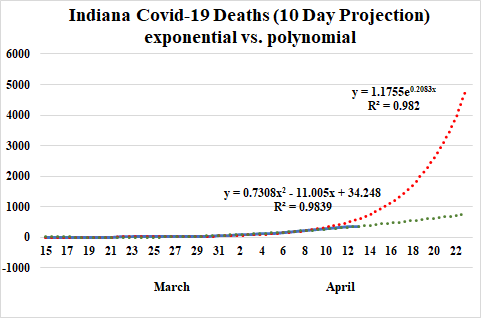1/n Some more back of the envelope thinking about the state& #39;s response to COVID-19, and how it has wider applicability. Let me preface by saying this is the sort of work military or gov& #39;t staff& #39;s perform. We haven& #39;t the luxury of time a academic work demands.
2/n Indiana began social distancing and school closures, then moved fairly quickly to a shelter-in-place order. The state has tweaked the order, and @govholcomb has provided clear, consistent and well informed information, moved decisively and set the example.
3/n My quick benefits model (not quite an epi-model, but in that spirit) compares two courses of action: Nothing (exponential disease spread) and Shelter-in-Place (polynomial disease spread). Perhaps five days ago it became clear we moved into the polynomial range.
4/n Again, it is too soon to know for sure, but this is decision support modeling, not peer reviewed epidemiology (which I don& #39;t do) or peer reviewed economics (which I do). The 10-day out difference in mortality is stunning, perhaps 4,000 deaths separate the two approaches.
5/n Now assigning the current EPA & #39;value of life& #39; estimates to this curve, I calculate about $36.8 billion in savings from lives preserved by actions of this state& #39;s government. If you go to 14 days, the figure doubles to over $70 billion. That is 9.8% and 20% of state GDP.
6/n These estimates are below the expected deaths the CDC, U. Wash and other models project without containment efforts. So, I feel these are conservative mortality estimates. How might we consider the trade-off between the costs and benefits of these governmental actions?
7/n I& #39;ve recently projected economic effects of the Shelter-in-Place, along with other Covid-19 related effects (supply disruptions from Wuhan, the wealth effect of stock market declines, etc.). My estimates of the Shelter-in-Place and social distancing (state mandates) are . .
8/n . . . an annualized loss of about 12.8% of GDP in 2nd quarter, or roughly 3.2% of the state& #39;s GDP this year (if it continues through June 30). The cost of those efforts are then about $12.1 billion, or about 1.3 the value of the lives saved from shelter-in-place.
9/n So, this is a rough model. The epidemiological estimates could be refined, the value of life can be constantly adjusted for actual victims demographics, and we could do several different economic scenario& #39;s of lost economic activity. Lots to quibble with in these estimates.
10/n None of those changes will alter the fundamental calculation that the benefits of what Indiana has done far exceed the costs.
If you are one of those ppl complaining that the deaths were not as bad as expected, and we should & #39;re-open& #39; the economy bring your math.
If you are one of those ppl complaining that the deaths were not as bad as expected, and we should & #39;re-open& #39; the economy bring your math.
11/n Since I& #39;ve done some epidemiology here, let me also do some philosophy. First, the lives & #39;saved& #39; are more likely to be sick, elderly and minorities. I& #39;m not a Rawlsian, but this is a good place to apply his max-min approach. Doesn& #39;t change the result, but helps the soul.
12/n Second, for you few souls who think it necessary we "save the economy" let me be clear. The & #39;economy& #39; is not a thing. It is a shorthand word to describe the interactions of people who & #39;truck and barter& #39; goods and services. Thought you should know.
13/n I think Indiana was, and in many ways remains unprepared for COVID-19. Thus far @GovHolcomb and his staff have done well at reacting to these specific challenges.

 Read on Twitter
Read on Twitter


